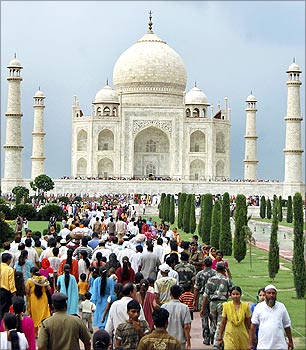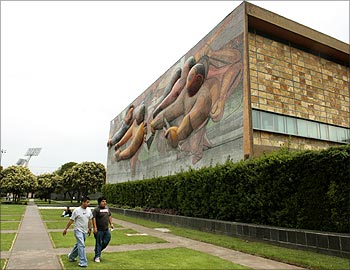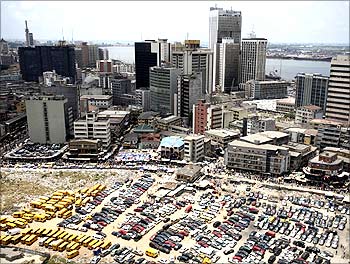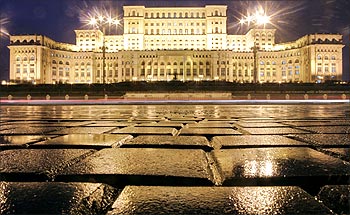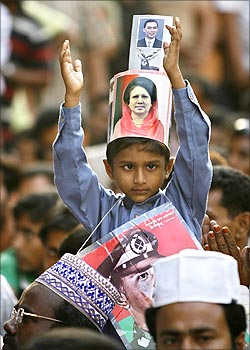 | « Back to article | Print this article |
Remittance: India again tops the world
India has retained its position as the highest recipient of global remittance flow at $52 billion in 2008, the World Bank has said in a report.
Remittance is defined as the sum of money paid to someone at a distance. A 'remittance transfer' refers to the transfer of money from an individual, usually a person who has emigrated from her city or country of origin, to another individual, usually a relative who remains at home.
The World Bank and the Bank for International Settlements have developed international standards for remittance services. To know more about nations that top the share of remittance, read on. . .
India: Rank 1
India received the highest of 15 per cent of the total global remittance inflows at $52 billion in 2008, which constituted 3.3 per cent of its gross domestic product. Remittance flows to developing countries reached $328 billion in 2008, an increase of 15 per cent over 2007.
It should be mentioned here that the World Bank had predicted a 7.3 per cent decline in remittance flows to developing nations in 2009 to $304 billion.
Most of the remittances happen by conventional channels like Western Union and Moneygram. However, with the increasing reach of the Internet, online money transfer has gained momentum.
During disasters or emergencies, remittances can be a vital source of income for people whose other forms of livelihood may have been destroyed by conflict of natural disaster.
Growth of remittances to South and East Asia is also because of the switch in motivation for remittances from consumption to investment: falling asset prices, rising interest rate differentials and a depreciation of the local currency.
Remittance: India again tops the world
China: Rank 2
People's Republic of China is the largest country in East Asia and the most populous in the world with over 1.3 billion people, approximately one-fifth of the world's population.
Chinese population, like its Indian counterpart, has migrated to several parts of the world and has established a firm footing in new pastures through its skills, talent and professionalism.
China is the fastest growing major economy in the world. It now has the world's third largest nominal GDP -- 30 trillion yuan ($4.4 trillion). It is a member of the World Trade Organization and is the world's third largest trading power behind the US and Germany.
Remittance: India again tops the world
Mexico: Rank 3
Mexico is the fifth-largest country in the Americas and the 14th largest independent nation in the world.
As the only Latin American member of the Organisation for Economic Co-operation and Development, Mexican economy has developed as an upper middle-income country.
The country has the 11th largest economy in the world by GDP by purchasing power parity.
The remittances from Mexican citizens working in the US account for 0.2 per cent of Mexico's GDP and is the seventh largest source of foreign income after oil, industrial exports, manufactured good, electronics, automobiles and food exports. According to Mexico's central bank, remittances fell 3.6 per cent in 2008 to $25 billion.
Remittance: India again tops the world
Philippines: Rank 4
The Philippines, officially known as the Republic of the Philippines, comprises 7,107 islands in the western Pacific Ocean.
The Filipino economy is heavily reliant on remittances as a source of foreign currency, surpassing foreign direct investment.
The Philippines is a newly industrialised country, with an economy supported by agriculture but with substantial contributions from manufacturing, mining, service industries like tourism, business process outsourcing and also remittances from overseas Filipinos.
Remittance: India again tops the world
Poland: Rank 5
Poland is the 9th largest country in Europe with a population of over 38 million people.
Poland is considered to have one of the healthiest economies of the post-communist countries, with GDP growing by 6.1 per cent in 2006.
Since the fall of the communist government, Poland has pursued a policy of liberalising the economy. Privatisation of small and medium state-owned companies and a liberal law on establishing new firms have allowed the development of an aggressive private sector in the country.
Remittance: India again tops the world
Nigeria: Rank 6
Nigeria is the most populous country in Africa and the eighth most populous country in the world. The International Monetary Fund has projected a growth of 8.3 per cent for Nigeria in 2009.
The country's bulk of economic activity is centred in four main cities: Lagos, Kaduna, Port Harcourt, and Abuja.
Nigeria is the US's largest trading partner in sub-Saharan Africa and supplies a fifth of its oil and 11 per cent of oil imports.
Remittance: India again tops the world
Romania: Rank 7
Romania has the 9th largest territory and the 7th largest population (with 21.5 million people) among the European Union member states.
While Romania's income level remains one of the lowest in the European Union, reforms have increased the growth speed. Romania is now an upper-middle income country economy.
After the Communist regime was overthrown in late 1989, the country experienced a decade of economic instability and decline. From 2000 onwards, however, the Romanian economy was transformed into one of relative macroeconomic stability.
The country's GDP grew by 8.9 per cent in the first nine months of 2008, but growth fell to 2.9 per cent in the fourth quarter and stood at 7.1% for the whole 2008 because of the financial crisis.
Remittance: India again tops the world
Egypt: Rank 8
Egypt is one of the most populous countries in Africa and West Asia. Egypt's economy is one of the most developed in West Asia, backed by sectors like tourism, agriculture, industry and service.Egypt's economy depends mainly on agriculture, media, petroleum exports, and tourism. There are more than three million Egyptians working abroad, mainly in Saudi Arabia, the Persian Gulf and Europe.
However, a rapidly-growing population, limited arable land, and dependence on the Nile all continue to overtax resources and stress the economy.
Remittance: India again tops the world
Bangladesh: Rank 9
Bangladesh is the seventh most populous country in the world with a high poverty rate. However, per-capita (inflation-adjusted) GDP has more than doubled since 1975, and the poverty rate has fallen by 20 per cent since the early 1990s.
Despite continuous domestic and international efforts to improve economic and demographic prospects, Bangladesh remains a developing nation.
Although two-thirds of Bangladeshis are farmers, more than three quarters of Bangladesh's export earnings come from the garment industry. The industry now employs more than 3 million workers, 90 per cent of whom are women.
A large part of the country's foreign currency earnings comes from the remittances sent by expatriates living in other countries.
Remittance: India again tops the world
Vietnam: Rank 10
Historically, Vietnam has been an agricultural civilization based on wet rice cultivating. The Vietnam War destroyed much of the country's economy.
However, as a result of several land reform measures, Vietnam is now the largest producer of cashew nuts with a one-third global share and second largest rice exporter in the world after Thailand. Vietnam has the highest percentage of land use for permanent crops.
Besides rice, key exports are coffee, tea, rubber, and fishery products. Agriculture's share of economic output has declined, falling as a share of GDP from 42 per cent in 1989 to 20 per cent in 2006, as production in other sectors of the economy has risen.
